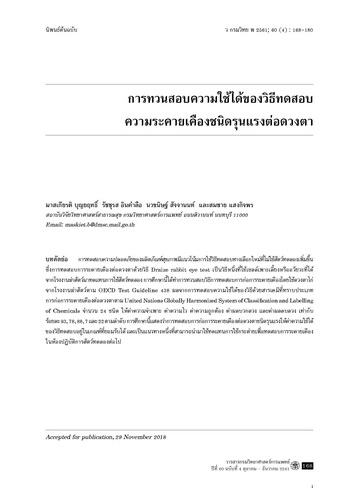การทวนสอบความใช้ได้ของวิธีทดสอบความระคายเคืองชนิดรุนแรงต่อดวงตา
บทคัดย่อ
การทดสอบความปลอดภัยของผลิตภัณฑ์สุขภาพมีแนวโน้มการใช้วิธีทดสอบทางเลือกใหม่ที่ไม่ใช้สัตว์ทดลองเพิ่มขึ้น ซึ่งการทดสอบการระคายเคืองต่อดวงตาด้วยวิธี Draize rabbit eye test เป็นวิธีหนึ่งที่ใช้เซลล์เพาะเลี้ยงหรืออวัยวะที่ได้จากโรงงานฆ่าสัตว์มาทดแทนการใช้สัตว์ทดลอง การศึกษานี้ได้ทำการทวนสอบวิธีการทดสอบการก่อการระคายเคืองโดยใช้ดวงตาไก่จากโรงงานฆ่าสัตว์ตาม OECD Test Guideline 438 ผลจากการทดสอบความใช้ได้ของวิธีด้วยสารเคมีที่ทราบประเภทการก่อการระคายเคืองต่อดวงตาตาม United Nations Globally Harmonized System of Classification and Labelling of Chemicals จำนวน 24 ชนิด ให้ค่าความจำเพาะ ค่าความไว ค่าความถูกต้อง ค่าผลบวกลวง และค่าผลลบลวง เท่ากับ ร้อยละ 93, 78, 88, 7 และ 22 ตามลำดับ การศึกษานี้แสดงว่าการทดสอบการก่อการระคายเคืองต่อดวงตาชนิดรุนแรงให้ค่าความใช้ได้ของวิธีทดสอบอยู่ในเกณฑ์ที่ยอมรับได้ และเป็นแนวทางหนึ่งที่สามารถนำมาใช้ทดแทนการใช้กระต่ายเพื่อทดสอบการระคายเคืองในห้องปฏิบัติการสัตว์ทดลองต่อไป
เอกสารอ้างอิง
Draize JH, Woodard G, Calvery HO. Methods for the study of irritation and toxicity of substances applied topically to the skin and mucous membranes. J Pharmacol Exp Ther 1944; 82: 377-90.
Balls M, Berg N, Bruner LH, Curren RD, de Silva O, Earl LK, et al. Eye irritation testing: the way forward. The report and recommendations of ECVAM workshop 34. Altern Lab Anim 1999; 27: 53-77.
ESAC statement on the conclusion of the ICCVAM retrospective study on Organotypic in vitro assay as screening tests to identify potential ocular corrosives and severe irritants as determined by US EPA, EU(R41) and UN GSH classifications in a tiered testing strategy, as part of a weight of evidence approach. [Online]. 2007 [cited 2017 Nov 1]; [3 screens]. Available from URL: https://eurl-ecvam.jrc.ec.europa.eu/about-ecvam/archive-publications/publication/ESAC26_statement_Organotypic_20070510c.pdf.
Vinardell MP, Mitjans M. Alternative methods for eye and skin irritation tests: an overview. J Pharm Sci 2008; 97: 46-59.
Hood E. Alternative test models: ocular safety assays accepted. Environ Health Perspect 2008; 116(9): A381.
Russell WMS, Burch RL. The principles of humane experimental technique. London: Methuen; 1959.
Scientific Committee on Consumer Safety. Memorandum on alternative test methods in human health safety assessment of cosmetic ingredients in the European Union. Brussels: European Commission; 2009.
Cosmetics and toiletries: report from ethical consumer. [Online]. 2017 [cited 2017 Nov 2]; [4 screens]. Available from: URL: https://ethicalconsumer.org/ethicalreports/cosmeticstoiletriesspecialreport.aspx
European Commission. Ban on animal testing. [Online]. 2017 [cited 2017 Nov 2]; [3 screens]. Available from: URL: https://ec.europa.eu/growth/sectors/cosmetics/animal-testing_en.
OECD. Test no. 438: Isolated chicken eye test method for identifying i) chemicals inducing serious eye damage and ii) chemicals not requiring classification for eye irritation or serious eye damage. Paris: OECD; 2017.
Burton ABG, York M, Lawrence RS. The in vitro assessment of severe eye irritants. Food Cosmet Toxicol 1981; 19(4): 471-80.
Prinsen MK, Koëter HB. Justification of the enucleated eye test with eyes of slaughterhouse animals as an alternative to the draize eye irritation test with rabbits. Food Chem Toxicol 1993; 31: 69-76.
Schutte K, Prinsen MK, McNamee PM, Roggeband R. The isolated chicken eye test as a suitable in vitro method for determining the eye irritation potential of household cleaning products. Regul Toxicol Pharmacol 2009; 54(3): 272-81.
McNamee P, Hibatallah J, Costabel-Farkas M, Goebel C, Araki D, Dufour E, et al. A tiered approach to the use of alternatives to animal testing for the safety assessment of cosmetics: eye irritation. Regul Toxicol Pharmacol 2009; 54(2): 197-209.
National Toxicology Program. Current status of in vitro test methods for identifying ocular corrosives and severe irritants: isolated chicken eye test method. [Online]. 2006 [cited 2017 Nov 10]; [168 screens]. Available from: URL: https://ntp.niehs.nih.gov/iccvam/docs/ocutox_docs/ocubrd/ice/icebrd.pdf.
van Stralen KJ, Stel VS, Reitsma JB, Dekker FW, Zoccali C, Jager KJ. Diagnostic methods I: sensitivity, specificity, and other measures of accuracy. Kidney Int 2009; 75(12): 1257-63.
Balls M, Botham PA, Bruner LH, Spielmann H. The EC/HO international validation study on alternatives to the draize eye irritation test. Toxicol In Vitro 1995; 9(6): 871-929.
Prinsen MK. The chicken enucleated eye test (CEET): a practical (pre)screen for the assessment of eye irritation/corrosion potential of test materials. Food Chem Toxicol 1996; 34(3): 291-6.
Lowther D, Prinsen M, Amcoff P, Barroso J, Zuang V, Kojima H, et al. International acceptance of in vitro alternative ocular safety testing methods: the isolated chicken eye test method (draft OECD TG 438). [Online]. 2009; [cited 2017 Nov 10]; [1 screen]. Available from: URL: https://ntp.niehs.nih.gov/iccvam/meetings/7thwc/lowther.pdf.
Kolle SN, van Cott A, van Ravenzwaay B, Landsiedel R. Lacking applicability of in vitro eye irritation methods to identify seriously eye irritating agrochemical formulations: results of bovine cornea opacity and permeability assay, isolated chicken eye test and the EpiOcular™ ET-50 method to classify according to UN GHS. Regul Toxicol Pharmacol 2017; 85: 33-47.
Verstraelen S, Van Rompay AR. CON4EI: development of serious eye damage and eye irritation testing strategies with respect to the requirements of the UN GHS/EU CLP hazard categories. Toxicol In Vitro 2018; 49: 2-5.




